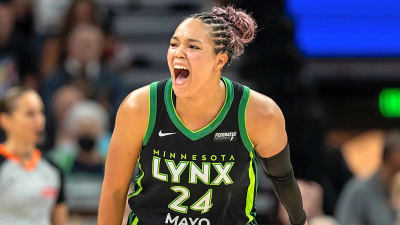
Amanda Anisimova’s loss in the Wimbledon final was painful to watch, but it told only one small part of her story. The American’s journey to the top of the game has been anything but conventional, marked by early brilliance, personal struggles, and an extraordinary comeback that arguably makes her one of the sport’s most compelling figures.
The signs were there from the very beginning. At just 14-years-old, Anisimova made her US Open debut with a statement win over the world #124, advancing to the second round of qualifying as a wild card. Most teenagers would have been overwhelmed by the moment. Instead, Anisimova announced herself as someone special.
What followed was a sequence of age-defying achievements. In 2018, she became the youngest player since 2005 to reach the fourth round at Indian Wells. A year later, at 17, she was the youngest French Open semifinalist in over a decade. And these were neither fluke runs nor lucky draws, they were strong performances by a player who was in full command of her game.
But tennis, cruel and unforgiving as it so often is, doesn’t allow many a straight path to greatness. Anisimova’s meteoric rise hit understandable turbulence as her development stalled and the pressures of professional tennis took their toll in the wake of her father’s untimely death. The decision she made next would define her career: she walked away.
Taking a break from tennis when you’re a rising star may seem counterintuitive. But Anisimova understood that burnout isn’t just physical. She needed to rediscover why she fell in love with tennis in the first place, while also giving herself a much needed mental break.
That hiatus proved to be the making of her. When Anisimova returned, she wasn’t just refreshed, she was transformed. This year alone has been a revelation, showcasing a player who has found the perfect balance between her natural gifts and hard work. The Wimbledon final may have ended in disappointment, but reaching it at all was a testament to her remarkable fighting spirit.
Yes, that loss was difficult. The nerves, the unforced errors, the weight of the moment seemingly crushing her, it had all the hallmarks of a player overwhelmed by the occasion. But here’s what matters in tennis: not how you fall, but how you get back up. Champions aren’t defined by their perfect moments but by their response to imperfection.
Anisimova’s answer came at the US Open, where she again reached the final. This time, while she still fell short of the title, she played with the composure and confidence of someone who belonged on that stage. The difference was stark, gone was the overwhelmed player, replaced by a player who understood her place among the elite.
The numbers don’t lie about where Anisimova stands in tennis history. Only three players born since 2000 have reached 150 WTA wins so far, a milestone she achieved recently in Beijing. Her company in this exclusive club? Coco Gauff, a generational talent and future Hall of Famer, and Iga Swiatek, the dominant force who seems destined for double-digit Grand Slam titles.
That’s the calibre of player we’re discussing. At 24, Anisimova is entering what could be the defining phase of her career. The comparison to Aryna Sabalenka is particularly apt. Sabalenka, after all, found her peak at 25 and has since become world number one with four Grand Slam titles. The blueprint exists for late bloomers who combine natural ability with the maturity that comes from weathering tennis’s storms.
Anisimova hasn’t won a Grand Slam yet, and there’s no guarantee she ever will. Tennis is too unpredictable, too dependent on moments and matchups. But what she has accomplished already marks her out as something special.
The beauty of Anisimova’s story isn’t just in her talent, which has always been evident, but in her resilience. She’s shown that career setbacks don’t have to be career endings, that sometimes the best thing a young athlete can do is step away to find themselves again. Her journey from teenage prodigy to burned-out player to Grand Slam finalist reads like a manual in personal growth.
What happens next will determine whether Anisimova joins the pantheon of tennis greats or remains a compelling what-if story. But based on her trajectory, her company among the sport’s brightest young stars, and her demonstrated ability to rise from setbacks stronger than before, betting against her seems unwise. At 25, with her best tennis potentially still ahead of her, Amanda Anisimova isn’t just a player to watch, she’s a player who might just rewrite the history of tennis.
More must-reads:
- McLaren’s intra-team championship fight heats up after dramatic Singapore GP
- What NASCAR Xfinity Series playoff standings look like after Charlotte Roval
- The 'MLB playoff debut strikeouts leaders' quiz
Customize Your Newsletter
 +
+
Get the latest news and rumors, customized to your favorite sports and teams. Emailed daily. Always free!








